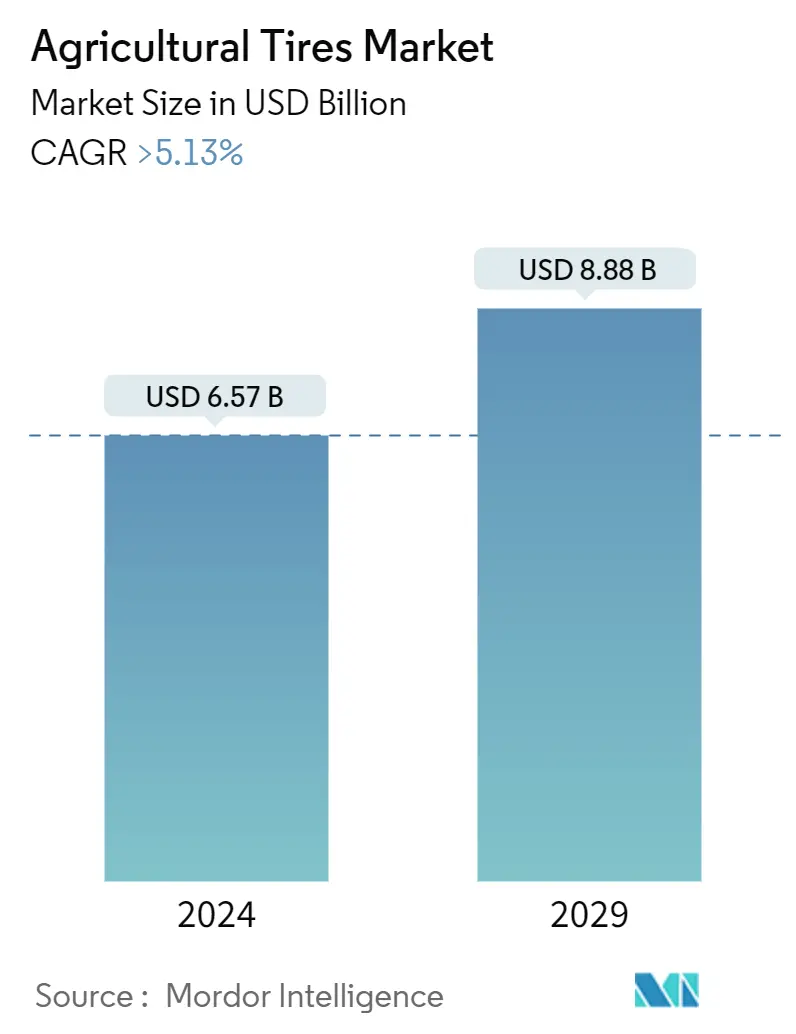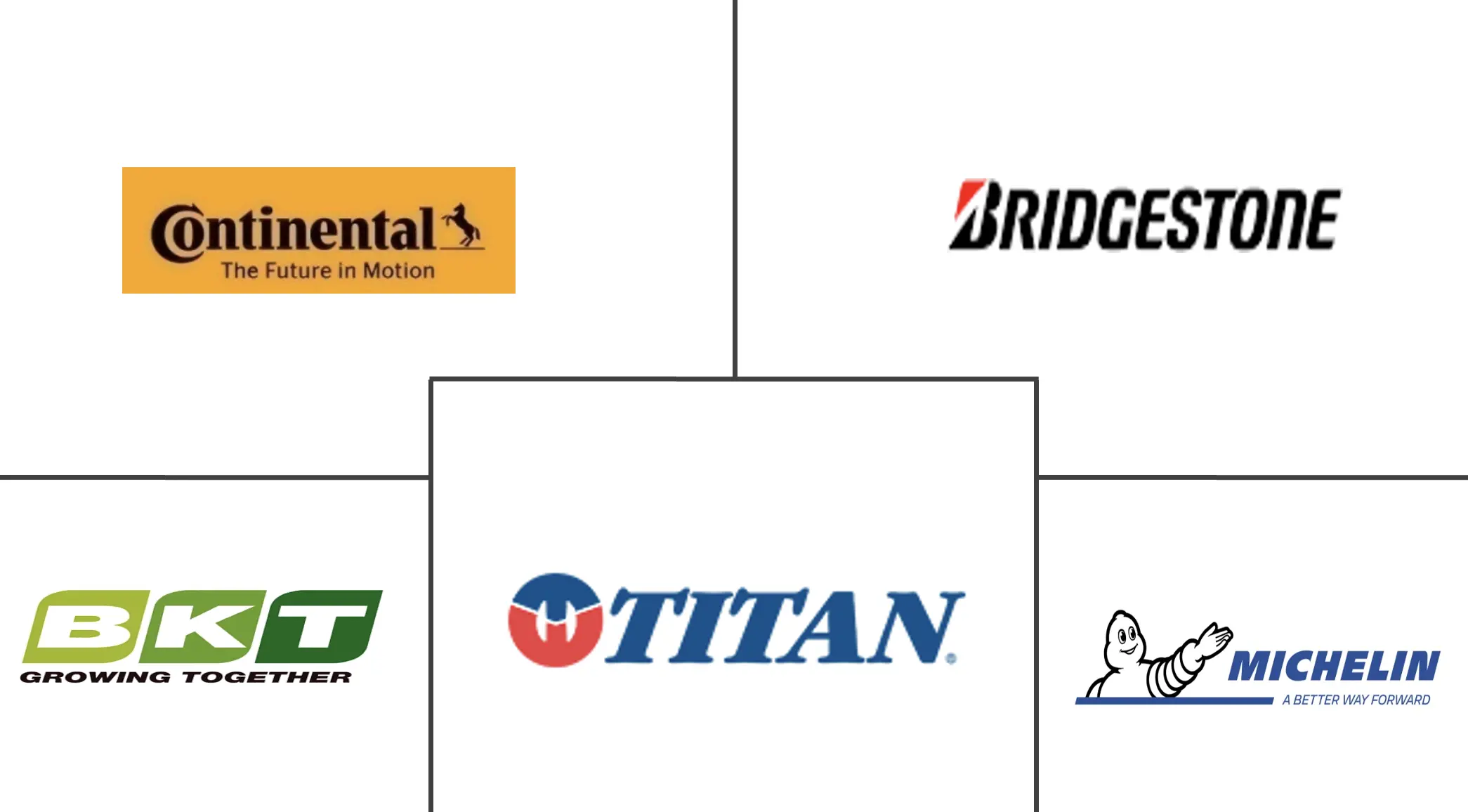Market Size of Agricultural Tires Industry

| Study Period | 2019 - 2029 |
| Market Size (2024) | USD 6.57 Billion |
| Market Size (2029) | USD 8.88 Billion |
| CAGR (2024 - 2029) | 5.13 % |
| Fastest Growing Market | Asia Pacific |
| Largest Market | Americas |
Major Players
*Disclaimer: Major Players sorted in no particular order |
Agricultural Tires Market Analysis
The Agricultural Tires Market size is estimated at USD 6.57 billion in 2024, and is expected to reach USD 8.88 billion by 2029, growing at a CAGR of greater than 5.13% during the forecast period (2024-2029).
The rise in demand for efficient and productive agricultural machinery end-products, especially among developed nations, drives the agriculture tires market. After China, Germany is the second-largest exporter and manufacturer of agricultural tires.
The demand for farm products from expanding populations and technological advancements in agricultural equipment are the primary factors propelling the market growth.
The agriculture tires aftermarket is highly fragmented and poses a high risk to OEMs in this field. Changing agriculture machinery design and increasing penetration into newer unknown terrain may require tires with newer and stronger rubber compounds. Floatation tires, forestry tires, trailer tires, and compound rubber tires with steel flex walls are the trending tires in the agricultural tires market.
Agricultural Tires Industry Segmentation
An agricultural tire is a specialized tire designed for use in agricultural machinery and equipment, such as tractors, combines, and harvesters. These tires are built to withstand the unique demands of agricultural applications, providing traction, stability, and flotation on various terrains. They are designed with deep treads, reinforced sidewalls, and strong carcasses to handle heavy loads, reduce soil compaction, and improve overall performance in farming operations.
The agricultural tire market is segmented by sales channel type, application type, tire type, and geography. By sales channel type, the market is segmented as OEM and replacement/aftermarket. By application type, the market is segmented as tractors, combine harvesters, sprayers, trailers, loaders, and other application types. By tire type, the market is segmented into bias tires and radial tires. By geography, the market is segmented as North America, Europe, Asia-Pacific, and the rest of the World. The report offers the market sizes in value (USD) for all the mentioned segments.
| Sales Channel Type | |
| OEM | |
| Replacement/Aftermarket |
| Application Type | |
| Tractors | |
| Combine Harvesters | |
| Sprayers | |
| Trailers | |
| Loaders | |
| Other Application Types |
| Tire Type | |
| Bias Tires | |
| Radial Tires |
| Geography | ||||||||
| ||||||||
| ||||||||
| ||||||||
|
Agricultural Tires Market Size Summary
The agricultural tires market is poised for significant growth, driven by the increasing demand for efficient and productive agricultural machinery, particularly in developed nations. This demand is fueled by the need to enhance operational efficiency amid rising labor costs and a shortage of farm labor, which is prompting greater mechanization in the farming industry. The market is characterized by a diverse range of tire types, including flotation, forestry, trailer, and compound rubber tires with steel flex walls, which are gaining traction due to their advanced features. The market landscape is moderately concentrated, with major players like Bridgestone, Titan International, BKT, Continental, and Michelin focusing on product innovation and customization to maintain their competitive edge.
In the United States, the agricultural sector's robust economic foundation, coupled with advancements in farming practices and equipment, supports a strong demand for agricultural tires. Despite a decline in the number of farms, the consolidation and modernization of the sector have led to larger, more technologically advanced farms, which require substantial tire investments to support their operations. The U.S. remains a leading agricultural producer and exporter, with a significant portion of its agricultural output relying on efficient equipment and practices. This export-oriented agriculture, along with government initiatives and subsidies in various countries, is expected to drive the demand for agricultural tires globally, as farmers increasingly invest in equipment to optimize productivity with a smaller workforce.
Agricultural Tires Market Size - Table of Contents
-
1. MARKET DYNAMICS
-
1.1 Market Drivers
-
1.1.1 Growing Global Population
-
1.1.2 Others
-
-
1.2 Market Restraints
-
1.2.1 Fluctuating Commodity Prices
-
1.2.2 Others
-
-
1.3 Industry Attractiveness - Porter's Five Forces Analysis
-
1.3.1 Bargaining Power of Suppliers
-
1.3.2 Bargaining Power of Buyers/Consumers
-
1.3.3 Threat of New Entrants
-
1.3.4 Threat of Substitute Products
-
1.3.5 Intensity of Competitive Rivalry
-
-
-
2. MARKET SEGMENTATION
-
2.1 Sales Channel Type
-
2.1.1 OEM
-
2.1.2 Replacement/Aftermarket
-
-
2.2 Application Type
-
2.2.1 Tractors
-
2.2.2 Combine Harvesters
-
2.2.3 Sprayers
-
2.2.4 Trailers
-
2.2.5 Loaders
-
2.2.6 Other Application Types
-
-
2.3 Tire Type
-
2.3.1 Bias Tires
-
2.3.2 Radial Tires
-
-
2.4 Geography
-
2.4.1 North America
-
2.4.1.1 United States
-
2.4.1.2 Canada
-
2.4.1.3 Rest of North America
-
-
2.4.2 Europe
-
2.4.2.1 Germany
-
2.4.2.2 United Kingdom
-
2.4.2.3 France
-
2.4.2.4 Spain
-
2.4.2.5 Italy
-
2.4.2.6 Rest of Europe
-
-
2.4.3 Asia-Pacific
-
2.4.3.1 China
-
2.4.3.2 Japan
-
2.4.3.3 India
-
2.4.3.4 South Korea
-
2.4.3.5 Rest of Asia-Pacific
-
-
2.4.4 Rest of the World
-
2.4.4.1 South America
-
2.4.4.2 Middle-East and Africa
-
-
-
Agricultural Tires Market Size FAQs
How big is the Agricultural Tires Market?
The Agricultural Tires Market size is expected to reach USD 6.57 billion in 2024 and grow at a CAGR of greater than 5.13% to reach USD 8.88 billion by 2029.
What is the current Agricultural Tires Market size?
In 2024, the Agricultural Tires Market size is expected to reach USD 6.57 billion.

